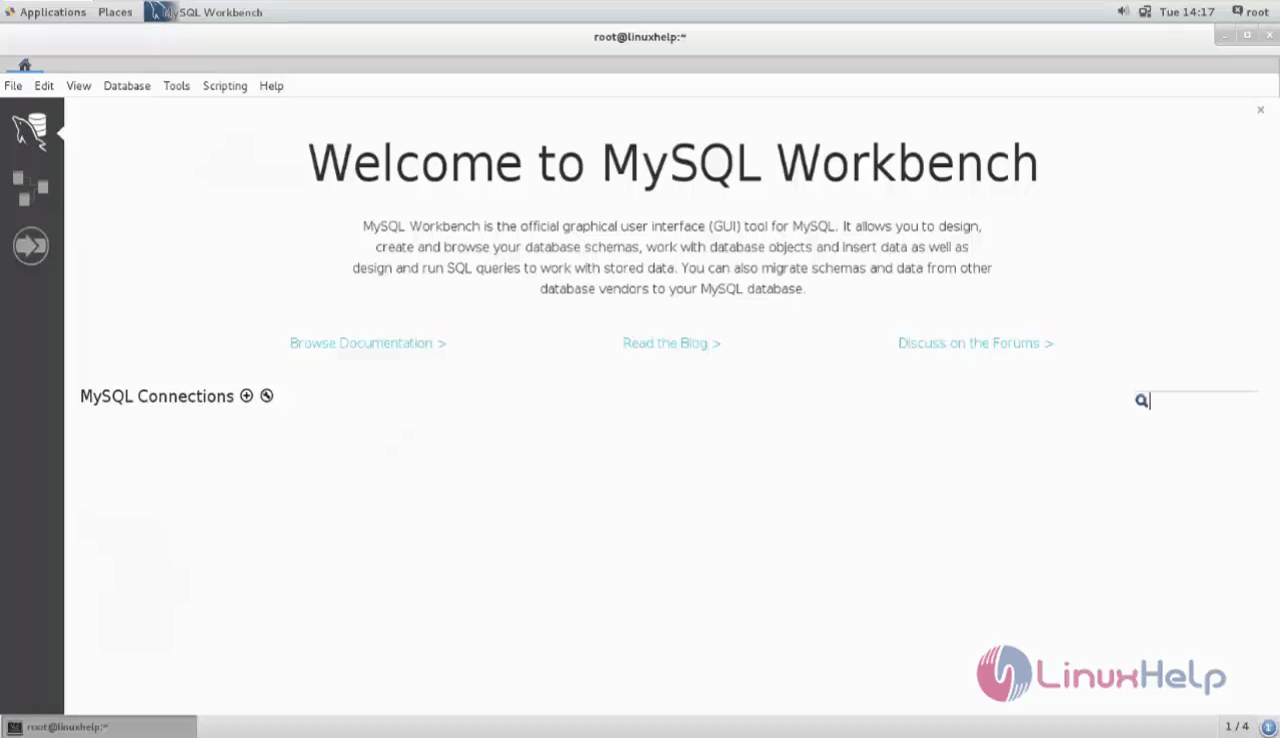How to install MySQL Workbench on CentOS 7.
To install MySQL Workbench on CentOS 7
MySQL Workbench is a cross-platform visual tool used by database administrators and developers to manage the MySQL Database. It is very simple to install MySQL Workbench. We have already covered the installation of MySQL Workbench on Debian and Ubuntu. This article covers the installation of MySQL Workbench on CentOS 7.
Installing MySQL Workbench
MySQL Workbench requires prior installation of the epel repositories. Use the following command for the same purpose.
[root@linuxhelp ~]# yum install epel-release -y
Loaded plugins: fastestmirror, langpacks
base | 3.6 kB 00:00:00
extras | 3.4 kB 00:00:00
updates | 3.4 kB 00:00:00
(1/4): base/7/x86_64/group_gz | 155 kB 00:00:00
(2/4): extras/7/x86_64/primary_db | 139 kB 00:00:00
(3/4): base/7/x86_64/primary_db | 5.6 MB 00:00:30
(4/4): updates/7/x86_64/primary_db | 3.8 MB 00:00:32
Determining fastest mirrors
* base: mirror.fibergrid.in
* extras: mirror.fibergrid.in
* updates: mirror.fibergrid.in
Resolving Dependencies
--> Running transaction check
---> Package epel-release.noarch 0:7-9 will be installed
--> Finished Dependency Resolution
.
.
.
Fingerprint: 6341 ab27 53d7 8a78 a7c2 7bb1 24c6 a8a7 f4a8 0eb5
Package : centos-release-7-0.1406.el7.centos.2.3.x86_64 (@anaconda)
From : /etc/pki/rpm-gpg/RPM-GPG-KEY-CentOS-7
Running transaction check
Running transaction test
Transaction test succeeded
Running transaction
Installing : epel-release-7-9.noarch 1/1
Verifying : epel-release-7-9.noarch 1/1
Installed:
epel-release.noarch 0:7-9
Complete!
Once it is done, install MySQL repository with the help of following command.
[root@linuxhelp ~]# wget http://repo.mysql.com/mysql-community-release-el7-5.noarch.rpm --2017-03-14 14:11:22-- http://repo.mysql.com/mysql-community-release-el7-5.noarch.rpm Resolving repo.mysql.com (repo.mysql.com)... 104.108.196.141 Connecting to repo.mysql.com (repo.mysql.com)|104.108.196.141|:80... connected. HTTP request sent, awaiting response... 200 OK Length: 6140 (6.0K) [application/x-redhat-package-manager] Saving to: ‘ mysql-community-release-el7-5.noarch.rpm’ 100%[===================================================================================================================================================> ] 6,140 --.-K/s in 0.01s 2017-03-14 14:11:22 (521 KB/s) - ‘ mysql-community-release-el7-5.noarch.rpm’ saved [6140/6140] [root@linuxhelp ~]# ls anaconda-ks.cfg Desktop Documents Downloads initial-setup-ks.cfg Music mysql-community-release-el7-5.noarch.rpm Pictures Public Templates Videos [root@linuxhelp ~]# yum mysql-community-release-el7-5.noarch.rpm -y Loaded plugins: fastestmirror, langpacks No such command: mysql-community-release-el7-5.noarch.rpm. Please use /usr/bin/yum --help [root@linuxhelp ~]# yum install mysql-community-release-el7-5.noarch.rpm -y Loaded plugins: fastestmirror, langpacks Examining mysql-community-release-el7-5.noarch.rpm: mysql-community-release-el7-5.noarch Marking mysql-community-release-el7-5.noarch.rpm to be installed Resolving Dependencies --> Running transaction check ---> Package mysql-community-release.noarch 0:el7-5 will be installed --> Finished Dependency Resolution . . . Running transaction check Running transaction test Transaction test succeeded Running transaction Installing : mysql-community-release-el7-5.noarch 1/1 Verifying : mysql-community-release-el7-5.noarch 1/1 Installed: mysql-community-release.noarch 0:el7-5 Complete!
Now, all is set for the installation of MySQL Workbench. Use the following command for the same purpose.
[root@linuxhelp ~]# yum install mysql-workbench -y
Loaded plugins: fastestmirror, langpacks
mysql-connectors-community | 2.5 kB 00:00:00
mysql-tools-community | 2.5 kB 00:00:00
mysql56-community | 2.5 kB 00:00:00
(1/3): mysql-tools-community/x86_64/primary_db | 32 kB 00:00:00
(2/3): mysql-connectors-community/x86_64/primary_db | 13 kB 00:00:00
(3/3): mysql56-community/x86_64/primary_db | 159 kB 00:00:00
Loading mirror speeds from cached hostfile
* base: mirror.fibergrid.in
* epel: sumberterbuka.beritagar.id
* extras: mirror.fibergrid.in
* updates: mirror.fibergrid.in
Resolving Dependencies
--> Running transaction check
---> Package mysql-workbench-community.x86_64 0:6.3.9-1.el7 will be installed
--> Processing Dependency: python-paramiko > = 1.15.1 for package: mysql-workbench-community-6.3.9-1.el7.x86_64
--> Processing Dependency: python2-crypto for package: mysql-workbench-community-6.3.9-1.el7.x86_64
--> Processing Dependency: proj for package: mysql-workbench-community-6.3.9-1.el7.x86_64
.
.
.
Dependency Installed:
libtomcrypt.x86_64 0:1.17-23.el7 libtommath.x86_64 0:0.42.0-4.el7 libzip.x86_64 0:0.10.1-8.el7 mesa-libGLU.x86_64 0:9.0.0-4.el7 postgresql-libs.x86_64 0:9.2.18-1.el7
proj.x86_64 0:4.8.0-4.el7 python-six.noarch 0:1.9.0-2.el7 python2-crypto.x86_64 0:2.6.1-13.el7 python2-ecdsa.noarch 0:0.13-4.el7 python2-paramiko.noarch 0:1.16.1-2.el7
Complete!
After installing MySQL-workbench, use the following command to launch the application
[root@linuxhelp ~]# mysql-workbench
Or, you can simply choose Applications --> Programing --> MySQL Workbench.

A simple way to install MySQL Workbench, wasn' t it? MySQL Workbench has a plethora of uses. MySQL Workbench is used for several purposes such as SQL Development as it enables the users to connect with the database servers and to access it, Data modeling and design, server administrations, data migration, and MySQL Enterprise Support which includes MySQL Enterprise Backup, MySQL Firewall, and MySQL Audit.
Comments ( 1 )